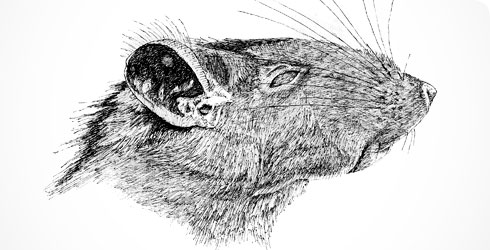Taxonomy
- The Kha-nyou is somewhat squirrel-like in appearance.
- The head is elongated, with small, rounded ears and long whiskers, the body is compact, with short legs and the tail is approximately half the length of the head and body.
- The body is covered in long, soft dense fur and the tail is also densely furred. Individuals vary in colour from dark grey to black on the back and flanks, some animals have lighter coloration on the undersurface and hindquarters.
- The head and body length averages 260mm (range 212 – 285mm), tail length 136mm (123 – 161mm) and two animals weighed 334 and 414 grams, respectively.
- There is little obvious sexual dimorphism in external appearance or size, although some individual males have longer guard hairs from the crown of the head onto the shoulders.
This recently discovered rodent was originally considered to belong to a completely new family, the Laonastidae (Jenkins et al. 2005). It was subsequently determined to be a living survivor or lazarus species of the otherwise extinct family Diatomyidae, formerly believed to have been extinct for approximately 11 million years (Dawson et al., 2006).
Further molecular studies of the relationships of this living fossil (Huchon et al., 2007) revealed that Laonastes (and by implication, the extinct members of the family Diatomyidae) is a sister clade of the Family Ctenodactylidae (gundis) that are confined to Africa, although fossil members of the family occurred in Eurasia.
Toolbox
Species name
The genus name Laonastes, means "inhabitant of stone" from the Greek
- laos = of stone
- nastes = inhabitant
in reference to its presence around limestone rocks and also to the country where it was recently discovered.
The species name aenigmamus means "enigma mouse" from Greek αινιγμα =
- ænigma = enigma
- mus, = mouse
referring to its unknown position among the rodents (Jenkins et al., 2004).
